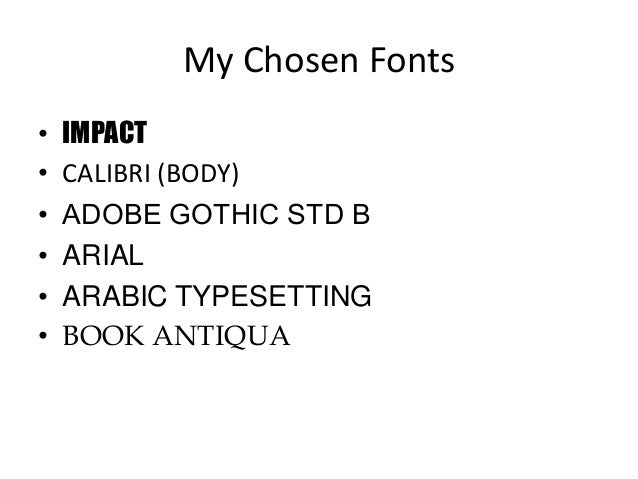
The best website for free high-quality Calibri Body fonts, with 20 free Calibri Body fonts for immediate download, and 9 professional Calibri Body fonts for the best price on the Web. Please contact us or report DMCA via email: contact@sharefonts.net.
| Calibri and Cambria Complete Family Pack |
| Calibri Complete Family Pack |
| Body Copy Sans Pro Italic |
| Body Copy Sans Pro Heavy Italic |
| Spillsbury Shaded Duo Body |
| Spillsbury Shadowed Duo Body |
| Body Copy Sans Heavy Italic |
| Bertoni Flamboyant™ Regular |
| Bertoni Capitals™ Regular |
| Bertoni Flamboyant™ Wide Bold |

| Bertoni Capitals™ Wide Bold |


The font that you choose for your book is more important than you think. It contributes to creating a more compelling book that readers are drawn to. Your choice also says a lot about you as an author. Different fonts can look more credible and professional, while others look tacky and overused. We tend to find serif fonts, like Times New Roman, more believable than sans serif fonts, such as Comic Sans MS. It’s important that your book looks more convincing than the books next to it on the shelf.
Choosing the right font is also vital for readability. When looking at a book online or an e-book, sans serif fonts tend to be easier for us to read. But when we read a book on paper, it is much better to use a serif font for the body of the text. A combination of sans serif and serif can be used to make a book more interesting and easier for the reader. Using sans serif font for things such as title and chapter headings, but serif for the main text, will create a believable and visually appealing book for your buyer.
You might have some favorite fonts, but if they’re on the list below, DO NOT use them in your book! Here our a few of our least favorite fonts:
7. Arial
We don’t mind Arial as a font, but if you’re going for a simple look, use Helvetica instead. The real reason is that Arial is too overused. It’s everywhere! Simplicity is good but try something that is not seen in every magazine and newspaper in town. Find something original that fits with the style of your book.
6. Copperplate
The big argument we have against this familiar font is that it is capitalized. It would be impossible to write an entire book in a capitalized font and would make it very difficult for the reader. It could be used for the title or cover page but again, it is very familiar and a bit overused.
Calibri Body Font For Mac Last Evil Version

5. Courier New
This font was designed to resemble an old typewriter, which is useful for certain situations. But the body of a book is not one of them. Courier New and other typewriter fonts are not personal and read very plainly. The typewriter-style makes it somewhat difficult to read as well, because of the fluctuation between the letters.
4. Curlz
Curlz seems like the perfect font for a little girl’s 8th birthday party, but not for the chapter headings in your novel. It is not a formal font and should not be used in a serious setting. If you used this font in the body of your book, your reader would get some serious headaches.
Calibri Body Font For Mac Last Evil Full
3. Brush Script
Brush Script is one fancy font! It’s a wedding invitation, handwriting-style font that is not suitable for book text. It might look professional at first, but in reality it just looks cheesy and cheap. It is also somewhat difficult to read, especially when compared to a font such as Helvetica, which is extremely legible.
2. Papyrus
Unless you’re making a PowerPoint presentation on ancient Egypt, Papyrus is not the right font to use. Papyrus is often seen in tacky signs, advertisements, and commercials. It is strange to say that we hate a font, but we hate Papyrus. It’s kitschy and used far too often by those who think it looks professional.
1. Comic Sans MS
Font

Oh, Comic Sans MS. You poor, poor font. Comic Sans is the world’s most notorious font, yet it is still widely used. Do not use Comic Sans. Ever. It is childish and goofy, lacking all credibility. There isn’t anything particularly wrong with Comic Sans (it’s widely used for a reason) but there are very few situations in which it’s appropriate to use, and your book is not one of them. Comic Sans, like Curlz, is among the least professional and least serious fonts, and therefore would not be convincing in a book meant for adults.
Though we just spent all that time dissing these fonts, there is nothing especially wrong with any of them. They were all created for a reason but are often used in the wrong setting. Using these fonts in general is never a bad thing, but they do not have a place in your book.
Are there any fonts that you despise? Let us know some of your least favorites!
Calibri Body Font Free
Have every new post delivered to your inbox every time we publish a new article. Your email address will never be shared!






